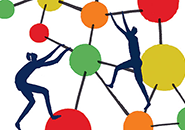When President Obama mentioned brain research in his 2013 State of the Union address, then launched the BRAIN (Brain Research through Advancing Innovative Neurotechnologies) Initiative soon after, people had questions. Is there a plan? Why this, why now? Where will the money come from? HHMI Investigator Cornelia Bargmann, who co-chairs the NIH-supported BRAIN working group with HHMI Investigator William Newsome, explains why now is the time.
Like most neuroscientists, I was surprised and excited when President Obama hailed efforts to map the human brain in his State of the Union address. It’s not often in basic science that we hear the President say that what we’re doing is important and should be accelerated. The goal of the BRAIN Initiative isn’t a passive map of brain structure, but an active map that shows the flow of traffic as well as the roads. The idea of constructing a full record of neural activity across the millions of circuits in the brain originated in a 2012 paper in Neuron by a group of scientists supported by the Kavli Foundation.
The new initiative caught everyone off balance and gave rise to two completely reasonable concerns: Where’s the plan? Where’s the money? Research in the United States is under stress already. With ongoing federal budget restrictions, biomedical research is in a world of pain. If I thought this project would be used as an excuse to drain money away from all the important basic science going on, I wouldn’t be involved.
We hope to see the BRAIN Initiative bring more resources into science. With programs like the Apollo space missions and Human Genome Project, new resources came with the national will to see those projects succeed. For the BRAIN Initiative, the federal government will spend $100 million the first year, several philanthropic organizations have committed resources to overlapping projects, and private industry is interested as well. If energy builds for these ideas, there are many ways to promote them.
Technologically, the timing is right. In the past, we’ve learned a great deal about the brain at the level of single neurons and synapses, and by whole-brain imaging. But somewhere between those two extremes is the level at which information is actually encoded to give rise to complex thoughts and behaviors—emotions, actions, perceptions, decisions. We know it’s not one neuron, or one region, that’s involved, and it’s not the whole brain. Some of the activity is localized and some is distributed, and it’s all changing in time and space.
A challenge of our time is to understand the shape of that intermediate level of circuits and systems of activity in the brain. Today, we can record hundreds of neurons at a time. But that’s still not enough; the number of neurons involved in any particular mental process may number in the high thousands to millions. These neurons aren’t just “on” or “off”; they have dynamic patterns of activity and dynamic relationships with each other. The tools developed by the BRAIN Initiative are aimed at capturing those network properties and dynamics, understanding which features are important, and finding out how they’re generated and what they mean.
We think we can leap to the next level of analysis because of progress in many areas of science: in recording neural activity with genetically encoded indicators; in developing optics and related instrumentation; in engineering very fast, sensitive cameras that can capture a huge amount of information in a short time. Today, optogenetics enables us to perturb neural activity or manipulate it to see how it affects behavior. That’s a big shift in the field from an observational to a causal science. At the same time, Silicon Valley companies now have the ability to analyze large, complex data sets.
All those things are happening already, but they’re not as good as they need to be. We need to scale up these methods 100- or 1,000-fold. We need deeper theoretical approaches. We need more insight into the powerful but still incompletely understood pictures we get from human brain imaging.
The BRAIN Initiative is about accelerating technology development, and our interim report for NIH spending on this program in fiscal year 2014, prepared with extensive input from the scientific community, sets out nine high-priority research areas of focus, including a plan for disseminating knowledge and training.
It’s been disappointing that drug development for brain disorders and psychiatric diseases has seen little progress over recent years, when the need is so great. Many pharmaceutical companies have pulled out of neuroscience drug development, and many promising avenues have failed, despite a lot of effort. Ask industry why they’re backing away from these problems, and they say it’s because we don’t understand enough about the brain. Those are our marching orders.








